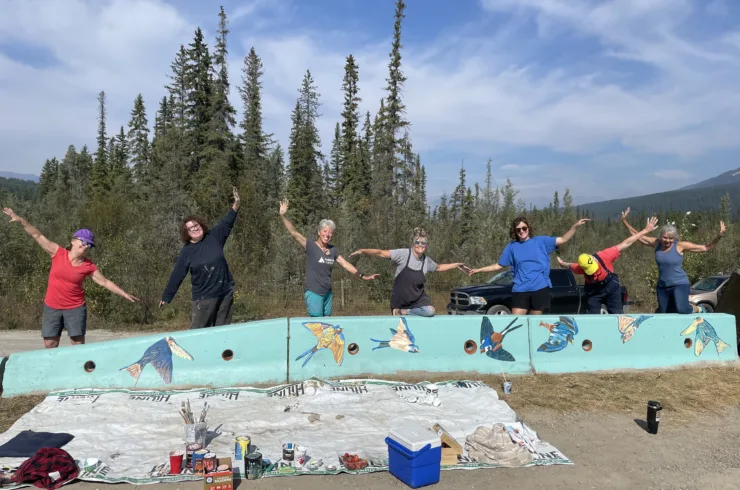Have you ever seen Rocky Mountain Bighorn Sheep in the Kicking Horse Canyon? Have you ever wondered about them? You are not alone! It is not at all rare to see these sheep on or near the TransCanada Highway #1. Their presence is a safety hazard: cars slow down to look or try to avoid hitting an animal; drivers stop, honk at, and occasionally hit the sheep.

Nevertheless, the sheep persist. The story of the Golden herd of bighorn sheep is an interesting look at survival of wildlife which coexist with a major freeway, live in close proximity to a town, and occupy a relatively small and extremely rugged area.
Phase 4 of the Ministry of Transportation and Infrastructure’s TransCanada highway widening project is happening and the associated disturbance and alterations to sheep habitat could further jeopardize the herd. This work is almost finished and we are hopeful that the new habitat will be an improvement. However, the few full bridges appear very low and moving from one end of their home range to the other could become challenging.
In hopes of helping the sheep survive, Wildsight Golden began the Golden Rocky Mountain Bighorn Sheep Project in January of 2019. In 2021 several findings were published and the limiting factors portion of the project was concluded. Remote-sensing camera work on escape structures began in 2020 and is ongoing.
Introduction to Golden Rocky Mountain Bighorn Sheep Project
The key recommendations of the study follow:
Alter fencing to allow access to critical winter and spring ranges without entering highway corridor.
Alter one-way gates and jump-outs to impede two-way use: Watch EwesGoingAgainstGate2
Improve winter and spring range quality by cultivating highly digestible and high-protein shrubs, forbs and grasses and removing invasive weeds and garbage
Document sources of required minerals within the study area and ensure access to mineral licks without entering highway corridor.
Create level to slightly sloping travel routes for sheep and other wildlife to use to move east to west through the canyon.
Ensure lambing area immediately west of Yoho bridge experiences limited to no disturbance from May 10 to July 30, annually Watch
Install speeding cameras and lighted signage in the canyon near areas of high use by bighorn sheep.
Place movable signage on Hwy 93/95 used during traffic diversion periods based on wildlife locations data.
The study was presented at the 22nd symposium of the Northern Wild sheep and Goat Council and published in 2021. The presentation is below:
CLICK HERE to see the publication.
This work has been done by Meg Langley, a semi-retired local wildlife biologist. You can CLICK HERE to see her resume.

Golden Rocky Mountain Bighorn Sheep Project Report Aug 2020
In 2018, Wildsight Golden’s Sheep Project began a long-term study to evaluate the cortisol levels in the sheep before, during and after highway construction. Cortisol is correlated with stress levels. The feeding of the sheep during the winters of 2022 and 2023 have confounded this data and other analysis approaches are being considered.

To bring attention to the sheep and related concerns, Wildsight Golden organized the “Vanishing Bighorns” art show in 2021. This show brings pieces created by 14 artists, each of who created a portrait of one member of the Golden bighorn herd as it was in 2019. We have created a permanent exhibition which can be seen CLICK HERE TO SEE THE ART with more details below.
The show went to Invermere: Vanishing Bighorns Exhibit Comes to Invermere
Learn more about Rocky Mountain Bighorn Sheep in B.C or watch some sheep videos here
Support the Radium sheep herd Act now: Save Radium’s Rocky Mountain bighorn sheep
Behaviours and indicators you might see:



Please read about our Vanishing Bighorn Art Exhibit here.
And at the Art Gallery of Golden here.
See our Bighorn Sheep video produced for the Comedy Show here.
We would like to thank our supporters and funding partners:











